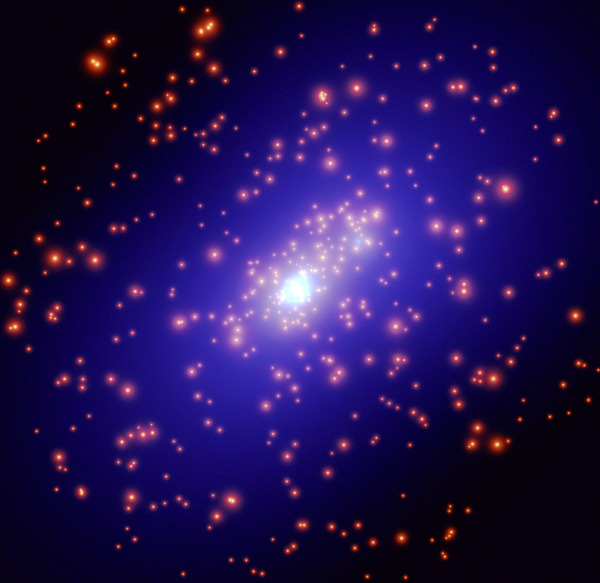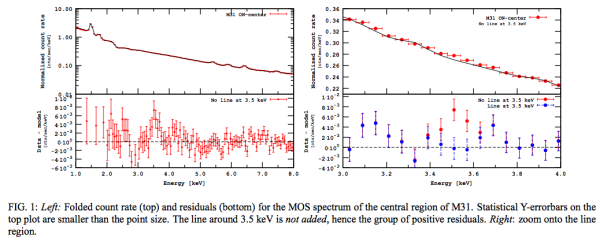“Time takes it all whether you want it to or not, time takes it all. Time bares it away, and in the end there is only darkness.” -Stephen King
This story seems to come up every few months. Someone detects a possibly unexpected signal somewhere in the sky -- normally correlated to the centers of galaxies or galaxy clusters -- and says: that's it, I found dark matter!
 Image credit: European Space Agency, NASA and Jean-Paul Kneib (Observatoire Midi-Pyrénées, France/Caltech, USA), via http://www.spacetelescope.org/images/heic0309a/.
Image credit: European Space Agency, NASA and Jean-Paul Kneib (Observatoire Midi-Pyrénées, France/Caltech, USA), via http://www.spacetelescope.org/images/heic0309a/.
Did you, though? The evidence has panned out to be a resounding no every single time upon closer examination. So what about these latest claims, are they going to be any different.
 Image credit: Alexey Boyarsky, Oleg Ruchayskiy, Dmytro Iakubovskyi, Jeroen Franse, screenshot via the full paper available at http://arxiv.org/abs/1402.4119.
Image credit: Alexey Boyarsky, Oleg Ruchayskiy, Dmytro Iakubovskyi, Jeroen Franse, screenshot via the full paper available at http://arxiv.org/abs/1402.4119.
In fact, we already know this current claim can't be responsible for the dark matter. Come find out why!
- Log in to post comments
More like this
“The total number of people who understand relativistic time, even after eighty years since the advent of special relativity, is still much smaller than the number of people who believe in horoscopes.” -Yuval Ne’eman
It's been 13.8 billion years since the Big Bang for us, and when we look out at a…
"Old age is like a plane flying through a storm. Once you're aboard, there's nothing you can do." -Golda Meir
It’s been 13.8 billion years since the Big Bang for us, and when we look out at a distant object in the Universe, we’re seeing it as it was in the past. Its age — as it appears — is…
"Science cannot tell theology how to construct a doctrine of creation, but you can't construct a doctrine of creation without taking account of the age of the universe and the evolutionary character of cosmic history." -John Polkinghorne
Out there in space, whether we look with our eyes or with a…
“I lie on the floor, washed by nothing and hanging on. I cry at night. I am afraid of hearing voices, or a voice. I have come to the edge, of the land. I could get pushed over.” -Margaret Atwood
We had a great run with Messier Monday, followed by a fun mini-series on Mini-Movie Monday, but now it's…





This is a question about the Big Bang. It is commonly stated that we don't know what came before the Big Bang but that we understand the physics immediately after the Big Bang.
I've real the usual description of how we get from the BIg Bang to today. But I don't think we really do understand it do we? I mean it's essentially just running everything backward until we have a concentrated point of matter.
We describe what would have to happen to get from A to B. There is still no explanation at all as to how this would happen.
After the Big Bang there is "inflation" and then suddenly there is a small ever expanding universe. That's the part that is never really explained. What physical force can actually cause that?
It makes sense after the universe is relatively large and it's just a matter of cooling off and allowing gravity to do its thing.
However, it's a big stretch to go from a dot to a small universe. That's not something that we can do on any scale in a lab is it?
It's bad enough to not understand dark matter and dark energy but to say that we basically understand everything from the Big Bang on but to just gloss over how exactly it's possible to go from a dot to something the scale of a universe is to miss the elephant in the room isn't it?
Thanks for the great article. I've got one question though. Given that dark matter does not interact electromagnetically, why should it be assumed that annihilations of dark matter particles would produce photos, which are after all carriers of electromagnetic force?
A couple of thought experiments:
(1) Lets assume DM decays into photons, either by decay, or via particlel/antiparticlel annihilation. Then there are likely some upper bounds on the decay rate, the simplest is DM still exists, so the rate of decay must be slower than X. Related there is only X amount of photonic energy, which places an upper limit on how much DM could have been lost. Perhaps there are some detailed observations on the evolution of the universe that provide tighter constraints.
Secondly, lets assume for the sake of a thought experiment, that there are two (possibly more) DM particle species and that one has a mass of 3.5KEv (the other is presumably heavier). Is there an upper limit on the fraction of DM mass that could be accounted for by the lighter species?
@jlnance #2: That's a good question. In fact, we don't have to make that assumption in general. Doing so means that we can calculate the cross-section quite precisely using quantum electrodynamics, so it's attractive only for that reason.
However, for this particular case, it's necessary if you want to use DM annihilation to "explain" this purported 3.5 keV X-ray line in galactic-center spectra. If DM doesn't annihilate to photons, then it would not produce a narrow feature in the spectrum.
@Gray #1: Your question is one which has been addressed by several of Ethan's postings, most recently in his "Ask Ethan #63", https://medium.com/starts-with-a-bang/ask-ethan-63-the-birth-of-space-a….
Basically, what you describe in your post is the ~1960's version of the Big Bang, which is understood today as being too simplistic to describe the cosmology we see and measure. The more modern version of "rewinding the clock" is that we can infer back in time right up to the very end of inflation (somewhere between the last 10^-33 and 10^-20 seconds). It is after inflation stops that the universe is "reheated" (from the conversion of the energy of inflation to something thermal), and we have what Ethan refers to as the "hot Big Bang."
What we _cannot_ infer, in any way, is just how long inflation had been going on before that point! Interestingly, the simplest assumption (as in Occam's razor simple) is that inflation had been going on, everywhere, for indefinitely long. At some point our "little patch" froze out of inflation and became the Universe we see. But elsewhere things are still inflating, or there are other patches which froze out before us, and others which froze out after us.
So when you read Ethan's postings, you'll see him rail mightily against all of the folks (mostly popularizations) which still describe things the way you did.
This is not to say we don't "understand" inflation. The field theory needed to drive inflation is actually rather simple ("simple" for a theoretical physicist :-) ). There are several competing models for how inflation could proceed which are equally viable. The problem we have, as observational and experimental physicists, is that none of those models (we think) are able to produce distinctive signatures that we might see in the cosmic microwave background. Consequently, it's hard to figure out how we could decide which one is "correct" (that is, which one describes the Universe we live in). Thus, we deliberately limit our claims to knowledge to the period after the end of inflation.
Is that a typo in the quote? Should it not be "...time takes it all. Time *bears* it away..."?
There is evidence of dark matter every time a double slit experiment is performed; it's what waves.
Dark matter has mass. Dark matter physically occupies three dimensional space. Dark matter is physically displaced by the particles of matter which exist in it and move through it.
The Milky Way's halo is not a clump of stuff anchored to the Milky Way. The Milky Way is moving through and displacing the dark matter.
The Milky Way's halo is the state of displacement of the dark matter.
The Milky Way's halo is the deformation of spacetime.
What is referred to geometrically as the deformation of spacetime physically exists in nature as the state of displacement of the dark matter.
A moving particle has an associated dark matter displacement wave. In a double slit experiment the particle travels through a single slit and the associated wave in the dark matter passes through both.
Q. Why is the particle always detected traveling through a single slit in a double slit experiment?
A. The particle always travels through a single slit. It is the associated wave in the dark matter which passes through both.
What ripples when galaxy clusters collide is what waves in a double slit experiment; the dark matter.
Einstein's gravitational wave is de Broglie's wave of wave-particle duality; both are waves in the Dark matter.
Dark matter displaced by matter relates general relativity and quantum mechanics.
Word salad, imbued with an utterly undeserved self-confidence.
NON-LINEAR WAVE MECHANICS A CAUSAL INTERPRETATION by LOUIS DE BROGLIE
“Since 1954, when this passage was written, I have come to support wholeheartedly an hypothesis proposed by Bohm and Vigier. According to this hypothesis, the random perturbations to which the particle would be constantly subjected, and which would have the probability of presence in terms of [the wave-function wave], arise from the interaction of the particle with a “subquantic medium” which escapes our observation and is entirely chaotic, and which is everywhere present in what we call “empty space”.”
The “subquantic medium” is the dark matter.
‘Fluid mechanics suggests alternative to quantum orthodoxy’
http://newsoffice.mit.edu/2014/fluid-systems-quantum-mechanics-0912
“The fluidic pilot-wave system is also chaotic. It’s impossible to measure a bouncing droplet’s position accurately enough to predict its trajectory very far into the future. But in a recent series of papers, Bush, MIT professor of applied mathematics Ruben Rosales, and graduate students Anand Oza and Dan Harris applied their pilot-wave theory to show how chaotic pilot-wave dynamics leads to the quantumlike statistics observed in their experiments.”
The “fluidic pilot-wave system” is the dark matter.
‘The pilot-wave dynamics of walking droplets’
https://www.youtube.com/watch?v=nmC0ygr08tE
In a double slit experiment it is the dark matter that waves.
Michael: see Paul Steinhardt talking about issues with inflation on John Horgan's blog. And note that whilst luke52's physics isn't great, space does have its vacuum energy which has a mass equivalence, and space is dark. And check out Einstein saying inhomogeneous space is what a gravitational field is.
If a particle is its own antiparticle, why doesn't it annihilate itself?
'Cosmologists at Penn Weigh Cosmic Filaments and Voids'
http://www.upenn.edu/pennnews/news/cosmologists-penn-weigh-cosmic-filam…
"Dark matter ... permeate[s] all the way to the center of the voids."
'No Empty Space in the Universe --Dark Matter Discovered to Fill Intergalactic Space'
http://www.dailygalaxy.com/my_weblog/2012/02/no-empty-space-in-the-univ…
"A long standing mystery on where the missing dark matter is has been solved by the research. There is no empty space in the universe. The intergalactic space is filled with dark matter."
Meaning, 'empty' space has mass.
Being its own anti-particle just means that when it encounters another like particle, there is a conversion reaction. It doesn't mean that a lone particle is necessarily unstable.
The reason a population of such particles wouldn't just instantly annihilate each other is low interaction cross-section (which means, low probability of interaction even when two particles come close. Think of it like two guns shooting bullets at each other, and trying to get the bullets to hit each other mid-flight: the odds of them not interacting with each other are much much higher than the odds of them doing so.)
'EPR program: a local interpretation of QM'
http://arxiv.org/abs/1412.5612
"Wave particle duality is described as the compound system of point particle plus accompanying wave (in the æther). "